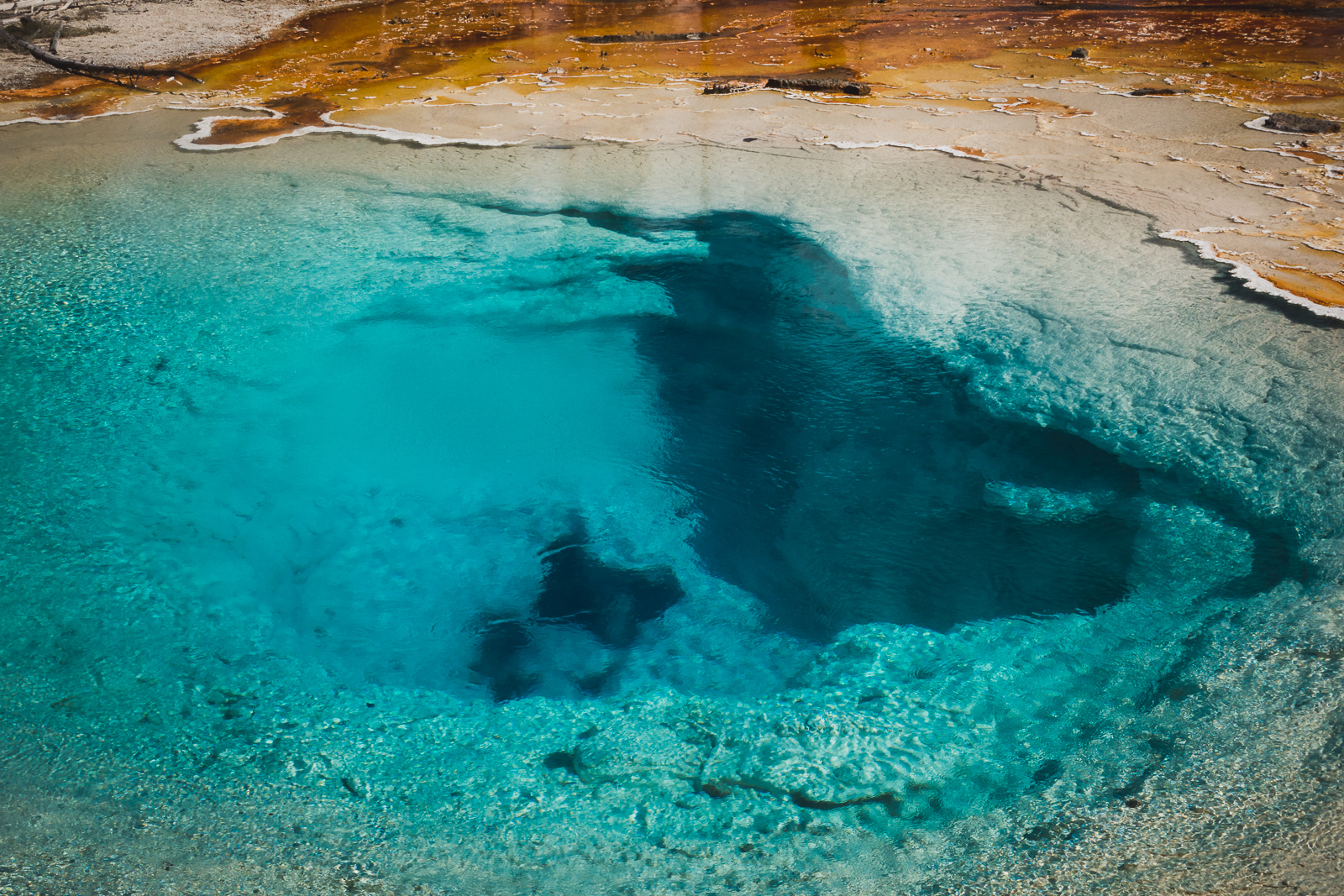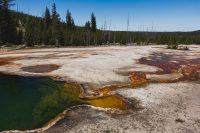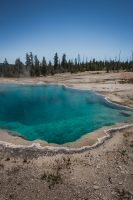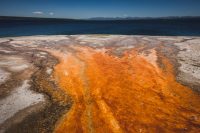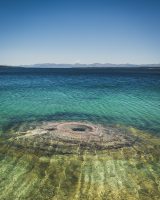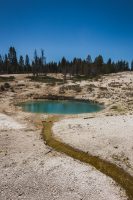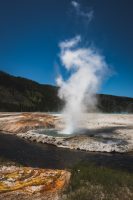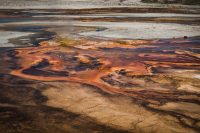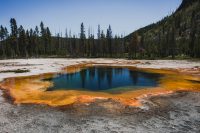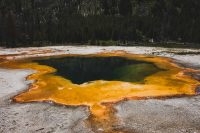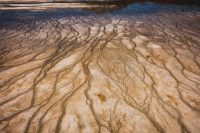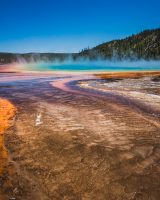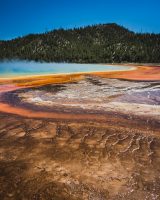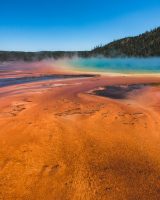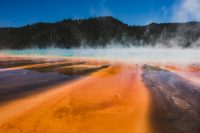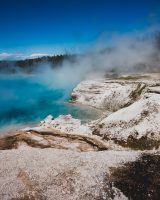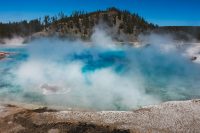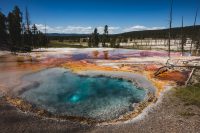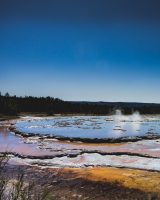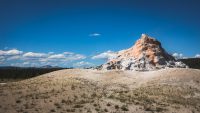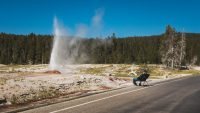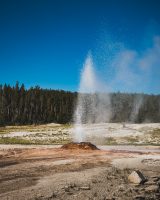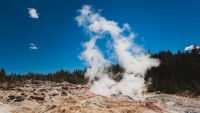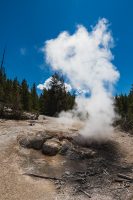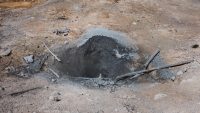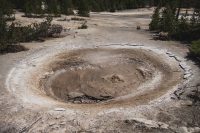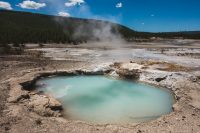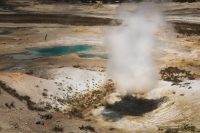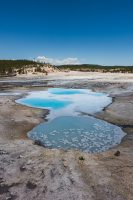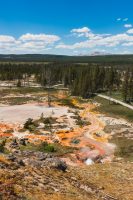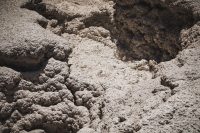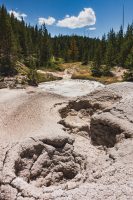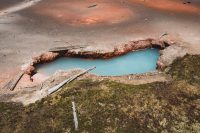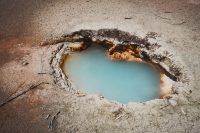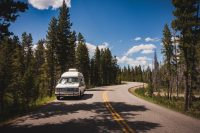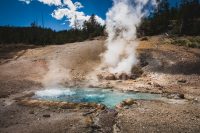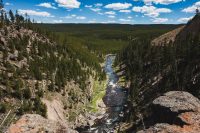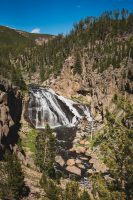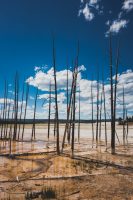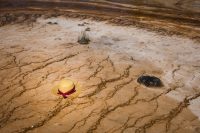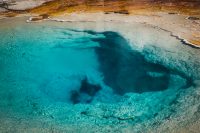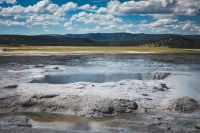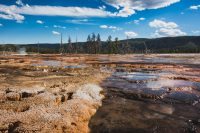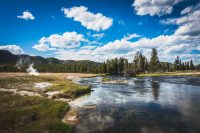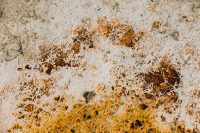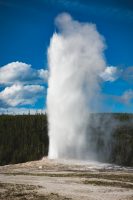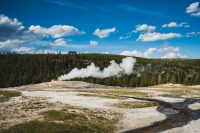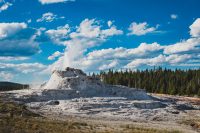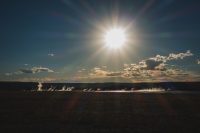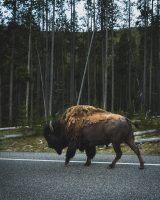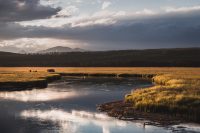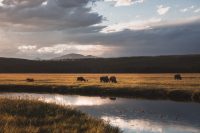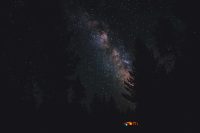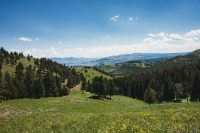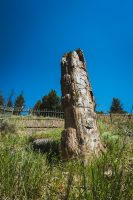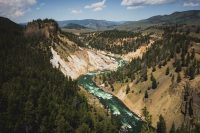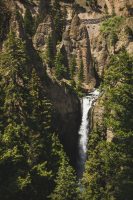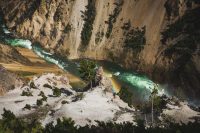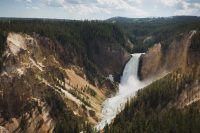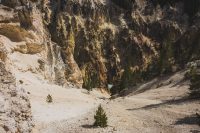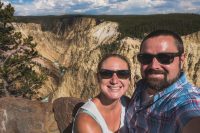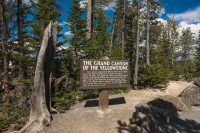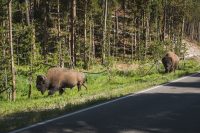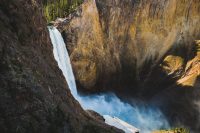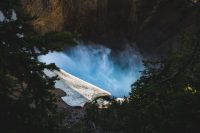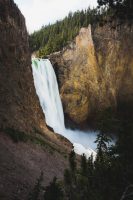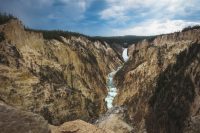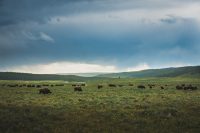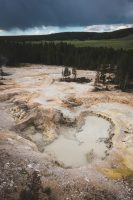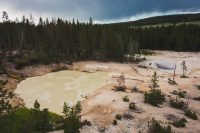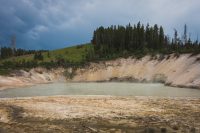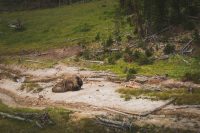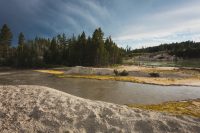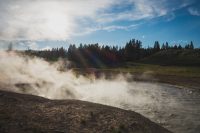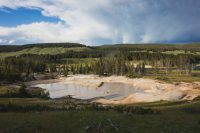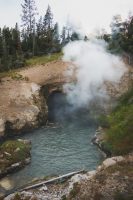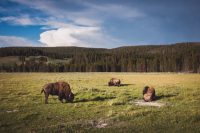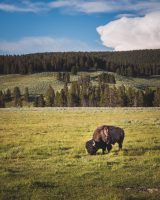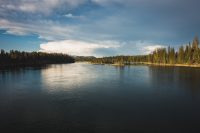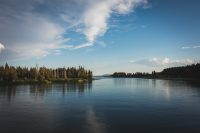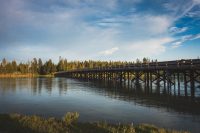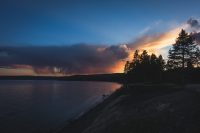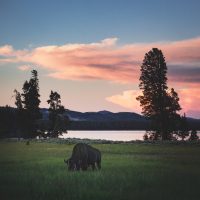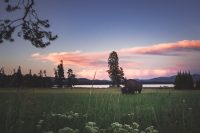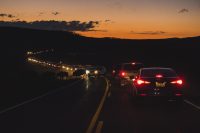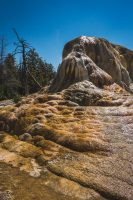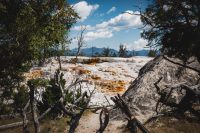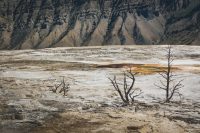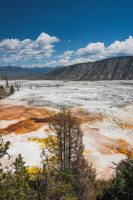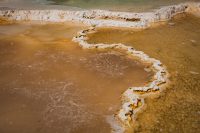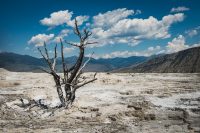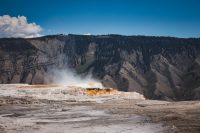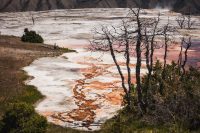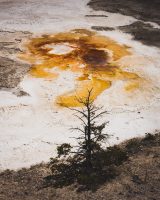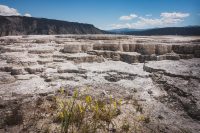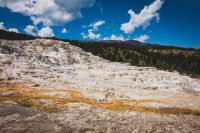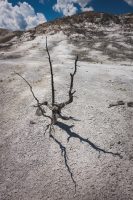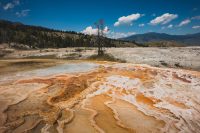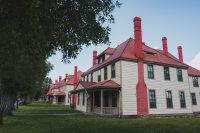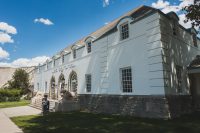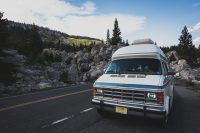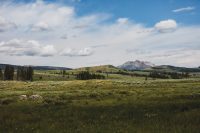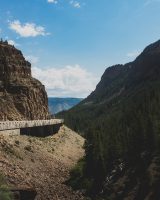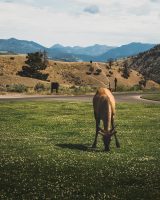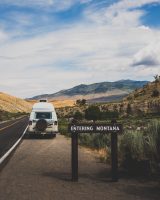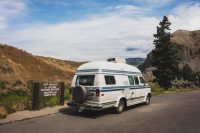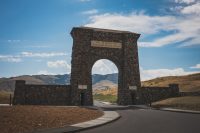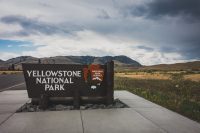June 26 – 30, 2016: After spending a few days in Grand Teton National Park we entered the south entrance of Yellowstone National Park via the John D. Rockefeller, Jr. Memorial Parkway which connects the two parks.
Yellowstone National Park is HUGE; it covers 2,221,766 acres. That’s larger than Delaware and Rhode Island, in the United States, combined. It’s over half the size of Wales. Or Belize.
Our first day, we covered a few stops on the western spur of the park road from the south entrance to the west entrance at West Yellowstone, Montana.
We started with a stop at Lewis Falls; a 29 foot waterfall surrounded by wooded area. Although it was pretty, it did nothing to prepare us for what we saw next at West Thumb Geyser Basin (located on the West Thumb of Yellowstone Lake). Walking the boardwalk (accessible interpretive trail) at West Thumb we got our first taste of the hydrothermal features that resulted in Yellowstone being named the first National Park in 1872 and a UNESCO World Heritage Site in 1978.
In addition to viewing hot spring pools, fumaroles, and geysers, we also learned a bit about the history of the region. Yellowstone Lake was formed approximately 2.1 million years ago by a volcanic explosion. The collapsed volcano (called a caldera) filled with water and formed Yellowstone Lake. The section of Yellowstone Lake referred to as ‘West Thumb’ is actually a caldera within a caldera. It was formed approximately 150,000 years ago by another volcanic explosion that created an extension to the lake.
FUN FACT: Yellowstone contains half (over 10,000) of all the known geothermal features in the world as well as the largest concentration (over 300) of geysers in the world.
After West Thumb Geyser Basin we stopped at Black Sand Basin, where we saw hot spring pools and a geyser eruption, and then at Midway Geyser Basin to wade through the crowds to view the iconic Grand Prismatic Spring.
Grand Prismatic Spring is the largest hot spring in the United States and the third largest in the world. The stunning colors are the result of thermophiles. Thermophiles are microorganisms that thrive in hot temperatures. Different types of thermophiles live at different temperatures and within each temperature gradation there are trillions of thermophiles that group together and appear as different colors.
FUN FACT: Hot springs are beautiful and sometimes stinky, but they can also be deadly. The water in hot spring pools can be as acidic as a car battery or hot enough to blister and burn your skin. Numerous accidents and deaths have been reported at Yellowstone National Park due to tourists not obeying posted signs. Please don’t be so stupid.
Our last activity of the day was Firehole Lake Drive, a one-way 3.3 mile scenic drive that winds amongst thermal features including Great Fountain Geyser, White Dome Geyser, and Firehole Lake.
We paused to watch geysers steam, boil, and erupt before driving onward and exiting the park to stay at a campground with electric hookups.
The next morning we re-entered Yellowstone National Park before 9AM to nab a campsite. Our preferred campground, Norris Campground, was already full so we made a mad dash further north to Indian Creek Campground where we were able to get a campsite. Now that we’re traveling in high season, we’re finding it more and more difficult to find availability at first-come first-serve campgrounds, especially in popular national parks.
We then continued to explore the park by heading back south. We hit up Norris Geyser Basin and viewed Steamboat Geyser, the world’s tallest active geyser, and then headed to Artists Paintpot. Here we saw mud pots. These were super interesting and we found ourselves just watching and listening to them for extended periods of time. Mud pots look like piles of boiling mud and make “plop, plop, plop” noises. They are actually the result of surface water collecting in a depression in the ground. Then, steam from thermal water beneath the depression heats the collected surface water which breaks down the soft rock into clay. Minerals present in the rock color the mudpots and gases cause the gurgles and bubbles. So, basically mudpots are piles of noisy clay. Loved them.
We stopped to observe Beryl Spring (one of the hottest springs in the park), the Gibbon Falls waterfall, drove the short scenic drive at Firehole Canyon (where there’s also a swimming hole), gazed at more mud pots and erupting geysers at Lower Geyser Basin, and watched fumaroles (steam holes) and geysers at Biscuit Basin.
Our final stop of the day was to watch Old Faithful erupt, spewing water and steam high into the sky. It erupts approximately every 90 minutes and there are benches set-up so you can sit and enjoy the show. The area also contains a number of other geysers and we were fortunate to also see activity at Castle Geyser.
The drive back to our campsite provided spectacular scenery and lots of bison sightings.
The next day was another long day but with lots of variety. We took a break from geothermal features and headed north from our campsite at Indian Creek Campground, past Mammoth Hot Springs, to the Blacktail Plateau scenic drive. This six mile one-way dirt road winds through woods and meadows and is supposed to be a great place to spot wildlife. This is also the area of the park where you’re most likely to have a wolf sighting. Unfortunately we didn’t see any wildlife. We then stopped to view a petrified tree; it was unique because it was still standing (unlike those we saw in Petrified Forest National Park).
Then, as luck would have it, we got our wildlife sighting near the Tower-Roosevelt Junction: two bear cubs in a tree! We don’t have a photograph because we were too busy gawking at the cuteness.
We continued south to the Canyon Junction area where we drove, stopping at overlooks along the way, North Rim Drive and South Rim Drive. On the south rim we hiked Uncle Tom’s Trail to view the lower falls. In my humble opinion, the number of people and metal staircase made this a hike we could have skipped. Also located on the south rim is Artist Point, a pretty view of chalky colorful mountains (but not as impressive as Death Valley National Park).
As we resumed our south-bound journey, we stopped at Sulphur Caldron and Mud Volcano. These stops were totally my style – I loved the unexpected beauty found in the unique, smelly, noisy geothermal features such as The Dragon’s Mouth, a turbulent hot spring with a steam vent ‘mouth’.
Our last stop was in the Fishing Bridge and Lake Village areas where we watched the sunset over Yellowstone Lake before heading back north to our campsite. And, although we already had a number of bison sightings, this drive was full of photogenic opportunities.
Our last full day in Yellowstone National Park we spent in the Mammoth Hot Springs area. We walked all of the boardwalks surrounding the upper and lower terraces. The terraces are formed when thermal water, containing calcium carbonate, rises through the limestone and deposits travertine. Colors are due to the presence of thermophiles.
We also walked around historic Fort Yellowstone, visited the Albright Visitor Center to learn about the history of the park, and viewed Roosevelt Arch in nearby Gardiner, Montana.
In closing, we now understand why Yellowstone was named our first national park in 1872. We understand why it is a World Heritage Site and a Biosphere Reserve. And we are grateful to those that had the forethought to protect and preserve our land.
TIP: It’s not likely you’ll have the time or energy to explore all of Yellowstone National Park. If we had to select a few highlights they would be to focus on the geothermal features: Grand Prismatic Spring at Midway Geyser Basin, the mud pots at Artists Paintpot, Old Faithful and other geysers, Sulphur Caldron, the Mud Volcano area, and the terraces at Mammoth Hot Springs.
Accommodation:
- Yellowstone Park / West Entrance KOA, West Yellowstone, Montana, United States
- Indian Creek Campground, Yellowstone National Park, Wyoming, United States
TIP: Most Yellowstone National Park campgrounds do not have hookups. However, Canyon Village Campground has a dump station with potable water right near its entrance.
